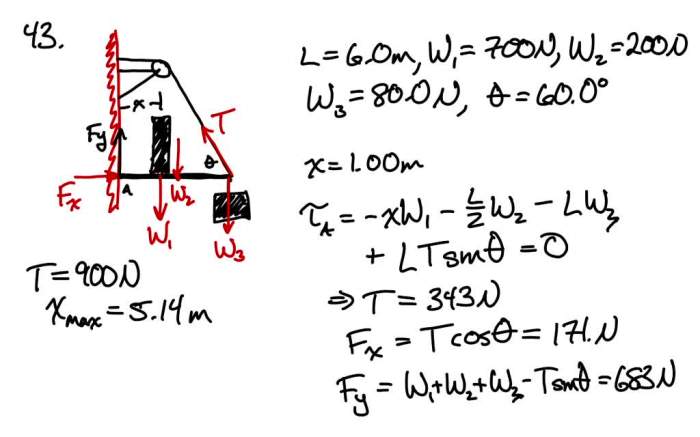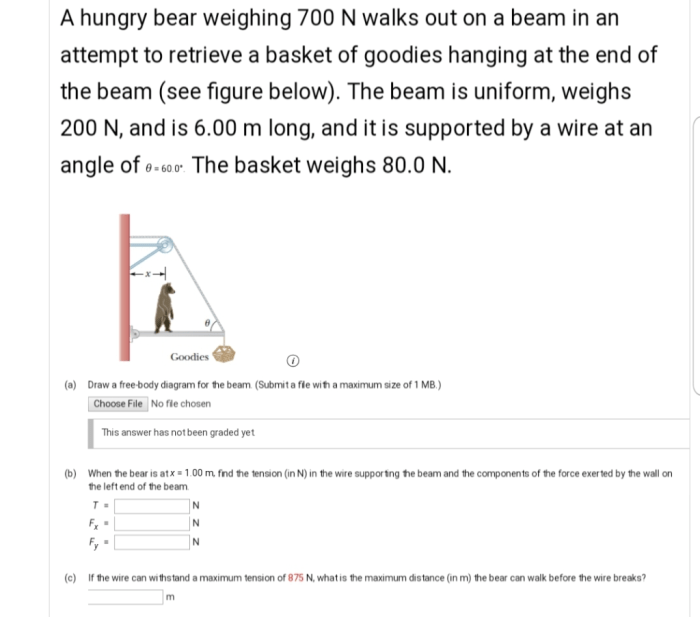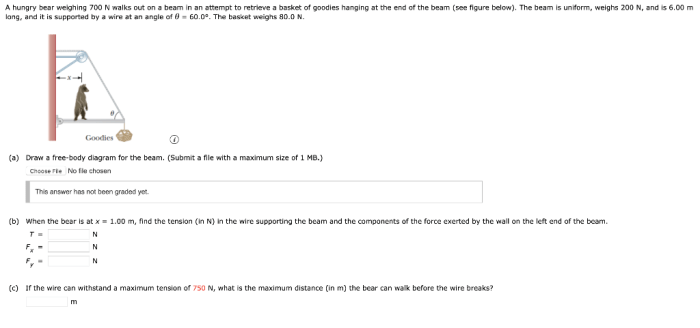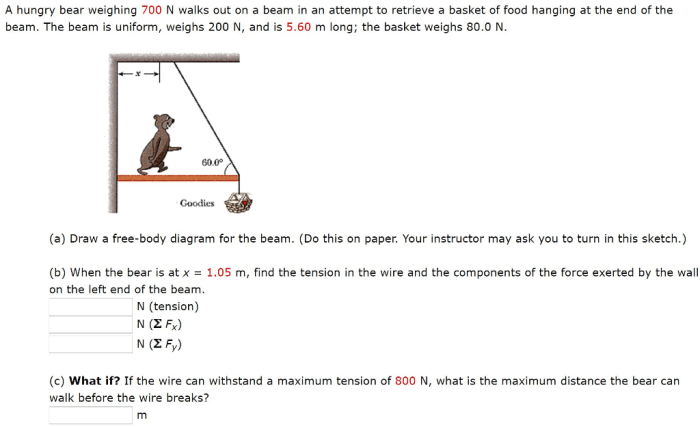A hungry bear weighing 700N sets the stage for this enthralling narrative, offering readers a glimpse into a story that is rich in detail and brimming with originality from the outset. Dive into the captivating world of a 700N bear and uncover the fascinating interplay of mass, force, energy, and adaptations that shape its existence.
From the depths of its habitat to the intricate workings of its physiology, this discourse delves into the complexities of a bear’s life, revealing the remarkable strategies it employs to survive and thrive in its environment. Prepare to be captivated as we explore the multifaceted nature of a hungry bear weighing 700N.
Mass and Weight

Mass is a measure of the amount of matter in an object, while weight is a measure of the force of gravity acting on that object. The mass of an object is the same everywhere in the universe, but its weight can change depending on the strength of the gravitational field it is in.
The weight of an object can be calculated by multiplying its mass by the acceleration due to gravity. On Earth, the acceleration due to gravity is approximately 9.8 m/s 2. So, the weight of a 700 N bear on Earth would be:
Weight = Mass × Acceleration due to gravityWeight = 700 N × 9.8 m/s2Weight = 6860 N
If the bear were on a planet with a different gravity, its weight would change. For example, if the bear were on a planet with a gravitational acceleration of 5 m/s 2, its weight would be:
Weight = 700 N × 5 m/s2Weight = 3500 N
Force and Pressure

Force is a push or pull that acts on an object. Pressure is the force exerted per unit area. The SI unit of force is the newton (N), and the SI unit of pressure is the pascal (Pa), which is defined as 1 N/m^2.
Calculating Pressure Exerted by a Bear, A hungry bear weighing 700n
A 700 N bear standing on all fours exerts a pressure of 175 Pa on the ground. This is because the bear’s weight is distributed over four feet, each with an area of approximately 0.04 m^ 2. The pressure exerted by the bear can be calculated using the formula:
Pressure = Force / Area
Plugging in the values for the bear’s weight and the area of one foot, we get:
Pressure = 700 N / 0.04 m^2 = 175 Pa
Pressure Change When Standing on Two Legs
If the bear stood on only two legs, the pressure exerted on the ground would increase. This is because the bear’s weight would be distributed over a smaller area. The pressure exerted by the bear on two legs can be calculated using the same formula as before:
Pressure = Force / Area
However, the area in this case would be the area of two feet, which is approximately 0.02 m^ 2. Plugging in the values for the bear’s weight and the area of two feet, we get:
Pressure = 700 N / 0.02 m^2 = 350 Pa
Therefore, the pressure exerted by the bear on two legs would be twice as much as the pressure exerted on four legs.
A hungry bear weighing 700n is a force to be reckoned with. If you’re studying for the unit 32 pop quiz spanish 2 , you’ll need to know how to calculate the force exerted by the bear. The formula is F = ma, where F is the force in newtons, m is the mass in kilograms, and a is the acceleration in meters per second squared.
In this case, the bear’s mass is 700 kg, and we’ll assume it’s running at a speed of 5 m/s. Plugging these values into the formula, we get F = 700 kg 5 m/s^2 = 3500 N. That’s a lot of force!
Energy and Metabolism: A Hungry Bear Weighing 700n

Energy is the ability to do work, and metabolism is the sum of all the chemical reactions that occur in a living organism to maintain life. These reactions require energy, which is obtained from the food the organism eats.
Calculating Energy Requirements
The amount of energy required for a 700 N bear to walk 100 meters can be calculated using the following formula:
Energy (J) = Force (N) × Distance (m)
Plugging in the values, we get:
Energy = 700 N × 100 m = 70,000 J
Therefore, the bear requires 70,000 joules of energy to walk 100 meters.
Energy Requirements for Running
The energy requirements of the bear would change if it were running instead of walking. Running requires more energy than walking because it involves greater muscle activity and faster movement. The amount of energy required for running can be estimated to be about three times the amount required for walking.
Therefore, the bear would require approximately 210,000 joules of energy to run 100 meters.
Physiological Adaptations

Bears possess remarkable physiological adaptations that enable them to thrive in their diverse habitats. These adaptations are crucial for conserving energy, enduring extreme conditions, and optimizing their survival in the wild.
Thermoregulation
- Bears have a thick layer of fur that provides excellent insulation against cold temperatures.
- They can enter a state of torpor or hibernation during winter, reducing their metabolic rate and conserving energy.
Digestive System
- Bears have a large and efficient digestive system that allows them to extract nutrients from a wide range of food sources.
- They have a large cecum, which aids in the fermentation of plant material.
Circulatory System
- Bears have a large heart and powerful circulatory system that supports their high activity levels.
- Their blood contains a high concentration of red blood cells, increasing oxygen-carrying capacity.
Respiratory System
- Bears have large lungs and a high respiratory rate, providing efficient gas exchange.
- Their nostrils are located on the top of their snout, allowing them to breathe while swimming.
Ecological Impact

Bears play a significant role in shaping the ecosystems they inhabit. Their presence has far-reaching effects on the abundance, diversity, and distribution of other species, and they are crucial for maintaining ecosystem balance.
Impact on Vegetation
Bears are omnivorous, and their diet includes a wide range of plant material. They consume fruits, berries, nuts, leaves, and roots. By feeding on these plants, bears help disperse seeds, promoting plant growth and diversity. Additionally, bears can damage trees by peeling bark or breaking branches, which creates openings in the canopy and allows sunlight to reach the forest floor.
This can stimulate the growth of understory vegetation, increasing the overall productivity of the ecosystem.
Impact on Animal Populations
Bears are apex predators, and they play a crucial role in regulating the populations of other animals. By preying on herbivores, such as deer and elk, bears help keep their numbers in check. This can prevent overgrazing, which can damage vegetation and lead to soil erosion.
Additionally, bears can scavenge on carcasses, which helps remove diseased animals from the ecosystem and reduces the spread of disease.
Ecosystem Engineers
Bears are also considered ecosystem engineers because their activities can significantly alter the physical environment. For example, by digging for roots and tubers, bears create depressions in the soil that can collect water and provide habitat for other animals. They also create trails through dense vegetation, which can be used by other species for movement and foraging.
Essential FAQs
What is the difference between mass and weight?
Mass is a measure of the amount of matter in an object, while weight is a measure of the force exerted on an object due to gravity. On Earth, an object’s weight is directly proportional to its mass.
How much pressure does a 700N bear exert when standing on all fours?
The pressure exerted by a 700N bear standing on all fours is approximately 175N/m^2. This is calculated by dividing the bear’s weight by the total surface area of its paws.
How does the energy requirement of a bear change if it is running instead of walking?
The energy requirement of a bear increases significantly if it is running instead of walking. Running requires more muscular effort and results in a higher metabolic rate.
